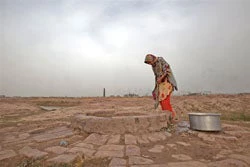
A Canadian and Dutch study reported by Reuters found that 80%of the world’s aquifers are used sustainably. This is good news but doesn’t diminish the sobering reality that groundwater is overused in a number of regions. The huge reserves sitting underground in parts of the globe, can and need, to be used wisely and sustainably. In Africa, for example, reserves of groundwater have been estimated in the order of 660,000 km3 but 330 million persons -- 40% of the population -- does not have access to safe water. Especially in dry North African Saharan countries like Libya, Algeria, Egypt and Sudan, as estimated by a team from the British Geological Survey and University College of London and reported by Reuters, the New York Times and some European papers.
However, as inviting as all that water under the Sahara is, benefiting from it is not that simple as pointed out in the New York Times article. For example, some of these reserves are at depths of 50 meters or more, requiring expensive deep water wells and large pipelines. Libya for example, is reported to have spent some $20 billion to supply Saharan groundwater to coastal cities and for irrigation. Moreover, water that was deposited under the Sahara an estimated 40,000 years ago is being extracted, but is not being replenished. There is a need to seriously think about how to sustainably develop but at the same time protect these aquifers. Raising the local capacity and standards for using the resource is as important as lowering the drilling costs. Other than the large aquifers under the Sahara there are not many places where enough water can be pumped from to sustain large-scale developments. Alan MacDonald of the British Geological Survey points out in the New York Times article that “a potential compromise may be to encourage small-scale irrigation using lower yielding water wells.” And dreams of cross-continental pipelines should not distract from finding ways to serve those who still have to take unsafe drinking water from ponds and holes in dry riverbeds.
As pointed out by UNESCO, a body of groundwater is a de-facto “jointly-owned property” and many problems are also administrative, legal and regulation-related. In the case of Africa, for example, at least 45 transboundary aquifers have been identified. These should be seen as vehicles for cooperation, rather than competition, and properly identifying and characterizing the aquifers is the first step, as reported in the New York Times article.
Do you agree? Do you disagree? Let us know what you think.


Join the Conversation